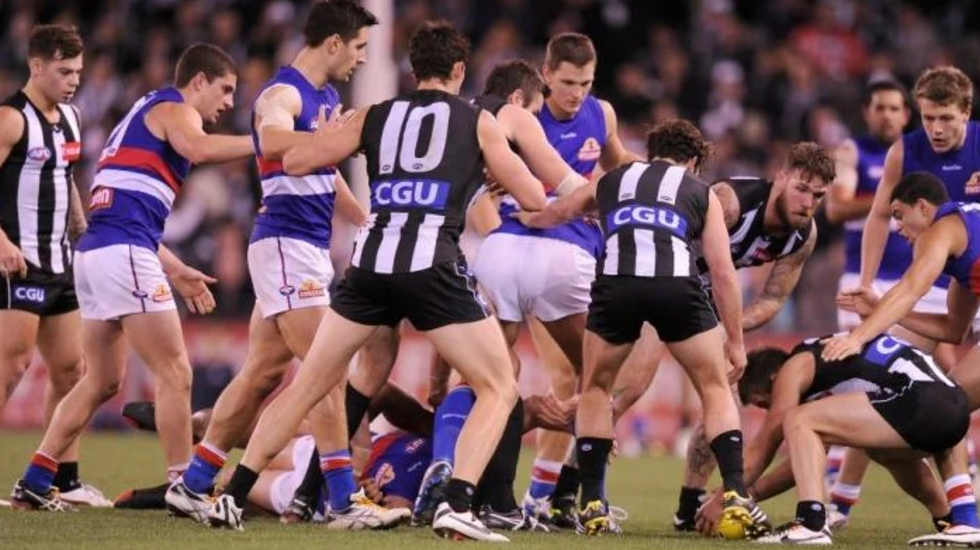Why not just have umpires blow for a ball-up quicker and refuse to allow players enough time to gather around a contest?
Piss-farting around. OK, it’s a crude expression, but to me it seems to pretty effectively encapsulate the sum total of the AFL’s latest tweaking of the rules of the game.
Not sure about anyone else, but I’m getting tired of these endless debates about the look of the game and potential improvements. Yet years and years of discussion and tinkering have produced next to no discernible change to trends we’re supposedly concerned about.
And already, I’m pretty confident the latest slew of changes will have about the same level of impact and ensure that this time next year, we’ll still be talking about the same stuff.
Interchange cap down from 90 rotations to 75? Seriously? How is that going to have any sort of effect on the game when a drop from an original limit of 120 rotations to 90 had next to none?
Tightening up the amount a player standing the mark can move laterally? Big deal. Next? The mark at kick-ins is being pushed back from 10 to 15 metres?
We’ve already increased that distance once, and it didn’t produce any real change in the amount players were prepared to play on from a behind kick-in. And even when they did, they pinched barely a few metres before just bombing long down the line to a contest and more congestion anyway.
The change with the most ramifications, of course, is the introduction of zones similar to 6-6-6 for throw-ins and kick-ins as well as centre bounces. That could make a dint. Yet there’s still significant “buts” there, too.
One is the amount of time consumed by players scrambling to get back in position for every throw-in and kick-in.
In normal length games (which we are apparently headed back to in 2021), there’s around 38 throw-ins and 21 kick-ins. So around 60 instances now of a pause in play while players reset positions, for what still be only a momentary easing of numbers around the ball. Is that a worthwhile trade-off? I’m not sure the returns will equal the cost.
Then there’s the competition in which this will be trialled next year, a new-look VFL now incorporating 22 teams from three states, stand-alone Victorian teams, AFL reserves teams, AFL club-aligned VFL teams and those previously in the NEAFL.
How is it going to be possible to even accurately gauge the impact of this trial on a competition starting afresh, playing to a level no-one can accurately tell perhaps for several seasons? Is any body of evidence going to be convincing enough to take the enormous step of introducing it to the AFL the following year?
We know that any sort of rule change annoys the game’s fan base. We know there’s a fair crossover between those most annoyed and those who simultaneously moan loudest about how the game is played these days. And yes, that’s frustrating.
But frankly, the effectiveness of the AFL’s pulling of various “levers”, as they have come to be known, has been so ineffective as to make the level of cynicism perfectly understandable.
Respected AFL analyst Rob Harding rightly points to the rationale of then AFL football operations manager Adrian Anderson when the substitute was introduced to the game for the 2011 season.
“The use of interchange has created more congestion, more stoppages, more defensive pressure and has contributed to a drop in disposal efficiency,” Anderson said as the AFL effectively attempted to turn four interchange players into three-and-a-half.
But was interchange really the cause? Clearly not. Through the five seasons (2011-15) of the substitute, two years (2014-15) of an interchange cap of 120, then a cap of 90 since, contested possession percentages have not once fallen below what they were when the sub was introduced.
Tackles and stoppage numbers have stayed around the same, and disposal efficiency has decreased. And scoring, as we all know by now, has continued to slide, at its lowest rate for more than 50 years.
Six-six-six was hailed on its introduction as a potential masterstroke. It hasn’t been of course, some would say very predictably given that, with an average of less than 23 goals per (full length) game, and allowing even 10 seconds for each centre bounce to unfold, you’re talking about a total of less than five minutes for the rule to work in games which last close to 120.
So, yes, that IS piss-farting around. Affecting a lot of change which amounts to nowhere near enough impact. If, of course, changing the game is what you intend. And even that point has to be debated.
Whilst I happily consider myself one of the “we need to do something” brigade who firmly believes football aesthetically was a vastly superior product in the 1990s, I also concede there is a considerable army of I think mainly younger fans for whom the game as played now, lower scoring, full of intense physical pressure and so very defence-orientated, is fine the way it is.
I prefer a decent amount of scoring, but even more so, freer, quicker movement of the ball in which running and bouncing is a feature. It appears so do those in charge of the game.
So why are they so reluctant to even trial measures which could make some sort of difference? More to the point, why do they appear so determined to solve the issues by decree and legislative change rather than by taking the far simpler route of changing umpiring interpretations.
PLEASE HELP US CONTINUE TO THRIVE BY BECOMING AN OFFICIAL FOOTYOLOGY PATRON. JUST CLICK THIS LINK.
If those steps were taken, who knows how much we might have freed things up already without having gone through this endless discussion about zones, centre bounce set-ups, longer goal squares, fewer rotations etc. bloody etc.
Take, for example, Collingwood coach Nathan Buckley’s personal hobby horse of taking away the “prior opportunity” caveat in holding the ball decisions, which would surely force quicker disposal. Whether you agree with him or not, surely that has the potential to make a bigger difference than a measly 15 fewer interchange rotations per team per game.
My personal favourite idea, and one I feel like I’ve been bowling up now annually for a good decade without so much as a murmur from AFL headquarters as to why it could work or why not, is, I believe, even simpler than Buckley’s, as it doesn’t even require a change to how possession and opportunity is determined.
It’s as simple as this – umpires refusing to allow more than three or four players at most to congregate around a contest or for a disputed ball contest to drag on interminably – before quickly blowing the whistle and immediately throwing the ball up for a re-start.
Obviously, that would require and end to the silly practice of nominating a ruckman, a saving of several seconds I doubt anyone would seriously argue against.
Significantly, a consistent feature of those games from the 1990s we tend to romanticise in terms of style is umpires doing just that. Look at any example from YouTube. Umpires are far quicker to blow the whistle for a ball-up, and far quicker to affect it (even when that required a bounce rather than a simpler toss upward).
There are virtually no examples of eight, nine, 10 players clustered around a disputed ground ball. Why not? Because they were never given the opportunity to cluster around that ball and force that congestion before the game was again got underway.
It really IS that simple. How on earth could we not even consider at least trialling that change in interpretation ahead of another whole set of rewritten laws? I seriously do not comprehend it.
But I also agree with the good judges that insist this isn’t so much about rules as coaching mindsets. And whilst a defensive philosophy prevails to the extent it has for a long time now, even in the art of attack, now based in, say, Richmond’s case, primarily around tackling pressure (a defensive art), we have to make it as difficult as possible to defend.
Making grounds bigger (as was the case with Waverley 50 years ago) is impractical. So isn’t the logical inverse of that to make the teams using the grounds smaller? I’m old enough to have watched plenty of VFA football played without wingmen and 16-per-side. It may not have always been the most skilful or evenly-matched spectacle, but one thing it was never was congested.
Again, I find it odd that while enough experts now have put forward the 16-per-side idea as a genuine solution, the AFL appears not to have uttered a squeak about it.
And forget that bloody charter of a few years back ritually cited as reason enough to stick with 18 players on the ground. Haven’t we seen enough change over the past decade to already have rendered that so-called sacred document completely obsolete?
The last of three suggestions I believe COULD actually make a significant difference, is the idea of bonus match points for teams based on scoring levels, whether that be 100 points, 90 or 80.
Yes, again, it’s radical change. But consider the potential plusses beyond offering a sizeable carrot for teams to attack more. Even a one-sided game could remain at least with some interest for the team in front, an incentive to continue to go flat-chat rather than put the cue in the rack and render the last rites of a game a complete yawn.
And again, like umpires calling quicker ball-ups, and like even 16-a-side, it isn’t interfering further with the rules of the game as such, simply offering greater rewards for teams to pursue higher standards in the elements of Australian football traditionally seen to have been among its greatest selling points.
The devil’s advocate argument here, of course, is that teams playing at venues more likely to be affected by adverse conditions might be at a disadvantage relative to teams which player under the roof at Marvel Stadium.
Is it that simple, though? In fact, it’s the Gabba which has been the AFL’s highest scoring of recent times. And it’s not as though our annual fixture isn’t heavily compromised in many respects like sides played twice, blockbuster requirements etc, etc.
Most mooted changes or implementations have an equivalent downside. That, however, isn’t reason enough not to give them a go.
These three ideas, to me, appear to offer far more likely fixes than the tiny little incremental changes we continue to see wheeled out as solutions. But none appear any closer to being put on the agenda, whilst we continue to piss-fart around with pulling the man on the mark back a few metres, or trialling things in competitions which have no historical basis for comparison (indeed, as yet, not even a name).
Increasingly, I feel like the AFL is so overly cautious on this stuff that we may spend a good 20 years fiddling around on the periphery of the game before accidentally arriving at a formula which does, finally, give us the sort of football we apparently want. Except, who is to say that will be the same game fans want in a couple of decades?
I’m not as convinced these days that football lovers of a much younger vintage necessarily want the same type of game that my generation does. At the same time, I am more convinced now that natural evolution has ground almost to a halt, and the game we see now is what will essentially remain unless change is affected.
Which means? That I think the AFL should be more careful in assuming we’re all on the same page about what sort of game football should be. And that if it is so intent on taking us back to the future as it were, it desperately needs to … yes … stop piss-farting around.












Last touch out of bounds for me! It seems natural to us as fans but in every other sport in the world, you have a marked off field our court, and it’s your job to keep the ball inside that area. Defenders seek out the boundary line so single-mindedly when kicking in, and when there’s a ball-up near the boundary line, there’s a 180 degree route for the clearance instead of 360 – much easier to defend. Maybe last disposal, not last touch, I’m not sure what would work best, but bring the game back into the corridor.
Paying a free kick against the 3rd man in when the initial tackled player and first tackler are on the ground would make a big difference. Keeps a one on one contest and everybody else outside the contest would need to be ready to receive the ball so would not crowd the ball in dispute. Simple to umpire because its obvious.
I agree the umpires let it go too long. Move it on. My umpriring grandfather would also bounce the ball on its end to bounce it sideways to clear congestion. That’s why the ball is oval and why umpires traditionally bounced the ball. Its not meant to be perfect.
Wouldn’t it be nice if they let the game evolve? There’s so many pissy little rule changes each year that the coaches barely have time to breathe, let alone work out ways to make attack more effective. Add to this the constant, week by week, changes in how they interpret the rules and it is no wonder coaches stay with what they know will work.
I disagree with most of the above I’m afraid, don’t like 16 a side at all, why not just allow players to throw the ball as well and call it the VFA?
I do wholeheartedly agree with the ridiculous amount of time they allow for packs to form. Watch an old game and the ball is locked in for a second and the umpire is in there bouncing it. The rucks are half way down the ground and it is far less congested. Ball it up in a hurry, no idea why they don’t.
One aspect of the prior opportunity rule seems to be missed. I think prior opportunity is reasonable given modern tackling techniques of pinning the arm. But there is another substantial change in the game people seem to be missing. Watch 2 players run at the ball years ago – if the player who is slower pushes or grabs at their opponent they are pinged for holding the man or push in the back, rules which apparently still exist despite evidence to the contrary. They would bump, which has always been legal, but they did not grab or push in the back. We want players to take possession but when you are being tackled before you take possession of the ball you definitely need to be given prior opportunity to dispose of the ball, after all, your opponent seems to have prior opportunity to tackle these days.
One last thing. There is a lot of talk about supposed issues with the game being too congested or some such imagined problem. Ok, fine the AFL apparently has an issue with the game (an issue not reflected in crowd numbers of TV ratings). So, what do they want the game to look like? Not some vague notion of less congested, whatever that means. What are they actually looking for? Either they don’t know or they aren’t saying.
DS
I agree on the bonus point. Instead of an interchange cap, just have interchanges only after a goal is scored or at the end of quarter breaks.
It’s not often I disagree with you Rohan but on this occasion I must admit that I disagree with a fair amount of what you’ve written here.
However, I would much rather talk about what we DO agree on… and that is the bonus points idea. I couldn’t agree more that it seems a no – brainer and I’ve never understood why it hasn’t taken on a more series tone with the AFL.
Footy was always going to become a defensive war of attrition and i for one think it has gone way too far. Something needs to be done for sure.
Let’s stay open to the idea of change at the very least.
Regards,
Matteo Marinacci